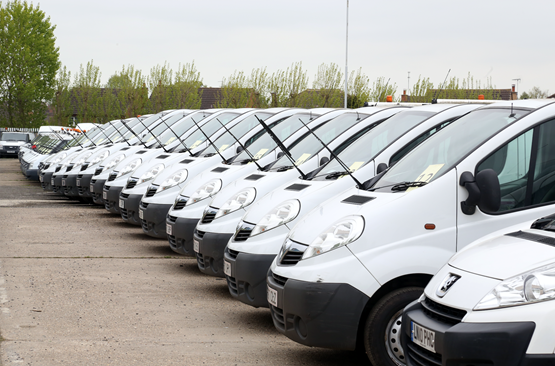Approach of Christmas is expected to boost LCV sales as home deliveries demand increases, Dean Bowkett reports.
Sorry, but I’ve got to say the ‘C’ word – Christmas is coming. I hate hearing and seeing about it in shops more than most, particularly when we haven’t even got past Halloween yet.
But Christmas is coming and that means good news.
No, I don’t mean that once again we get to enjoy (or should that be endure?) the last quarter of the year listening to that Slade record again, but the approach of the festive season is good news for the light commercial vehicle (LCV) market.
According to Shoreham Vehicle Auctions (SVA), UK online retail sales topped £133 billion in 2016 – a 16% rise compared to the previous year – and that translated into an increase in demand for good condition LCVs, particularly in the run up to the busiest time of the year for the retail industry.

Manheim has also noted that buyer’s feedback on August’s retail demand was “largely positive” and it was expecting demand to increase as we exited the vacation season. This gives the perfect mix of rising demand in general consumer retail shopping, creating an increased demand in the retail of vans as we head towards the shops’ busiest time of the year.
So far this year, we have repeatedly seen prices ahead of those experienced in 2016, with BCA reporting all LCVs up 5.4% for August 2017 over the previous year, a jump of £331. However, with the average age down three months to 50.48 months and mileage down 8%, not all of the increase they report can be attributed to the rising market conditions.
Among small UK firms, confidence is hitting its lowest level since the EU referendum, due to rising inflation and a slowing economy.

Against this background we are still seeing the average age of LCVs across most sales channels falling, as fleets shorten the rate of their change cycle.
Like BCA, Manheim also saw the average age fall, although in its case the fall in August 2017 vans was around four months lower than for the same period in 2016.
Even allowing for the younger age of vans being sold, the consensus is that demand and prices are continuing to rise, as Matthew Davock, head of LCV at Manheim, said: “Summertime van sale performances have been staggering and are proof of a super-heated marketplace.”
James Davis, director of CV at Manheim, confirmed that, saying he is “entirely confident of the robust nature of the used van market” adding that the “outlook remains positive”.
The confidence about the strength and sustainability of the UK used van market seems to be uniform as Tim Spencer, SVA commercial vehicle sales manager, confirmed “the three-year-old market continues to be extremely buoyant”.

While we saw a slowdown in overall volumes during the summer, the drop was small and contrasted with the demand which remained far more ebullient.
Manheim reported average conversion rates of 81% in August which was a year-on-year increase of 18% over August 2016, just ahead of SVA which have been seeing conversion rates of around 80%.
Glass’s chief commercial vehicle editor Andy Picton went even further, reporting staggering conversion rates averaging 90% “dependent on stock quality and variety” and also highlighting that sold stock levels during August “performed strongly returning a 15.2% month-on-month increase, which, in turn, was 5.9% up on the same point last year”.
Availability of good quality stock remains a key issue and SVA confirmed Glass’s view about needing vans to be offered in “good condition” with Spencer stating that for three-year-old vans “everything of that age is being snapped up and there remains a shortage of stock in the market”.

Picton confirmed the same, highlighting that “two-four-year-old stock has been the most sought after” throughout 2017 and that it made up 39% of all sales in August.
BCA LCV operations director Duncan Ward reiterated the importance of condition, saying: “It has always been the overriding factor for professional buyers and is critical to achieving first time conversion rates.”
The message from all sides is clear, fleets should be seeing plenty of demand for their used vans this year and the speed of conversion and the prices obtained should be putting a smile on faces.
But, to really win in this bullish market, fleets should ensure stock is in good condition, with all the relevant documentation in place and the vehicle needs to be well maintained.

In the fleet and leasing sector, the average age of vans fell slightly, dropping one month year-on-year to 39.27 months, according to BCA.
While not as dramatic as the general market decline, this is only to be expected given the contractual commitment when taking a van on lease which limits the speed at which the lessee can renew his fleet.
Taking this marginal decline into consideration, along with the average mileage drop of just more than 3,000 miles in August 2017 over the previous year, the average value increase of just £272 actually means prices remained pretty much flat as they hover around the £7,000 mark for the 11th consecutive month.
The same can be said for part-exchanges, with BCA reporting a five-month fall in the average age of LCVs to 78.43 and an almost 6,700-mile drop in average mileage.
But they generated just a £194 increase in average values.
The medium panel van sector seems to be enjoying an inexorable rise in used values.

Glass’s highlighted its versatility but also pointed out that it is being helped by the rise in better specified vehicles with air conditioning, metallic paint, automatic gearboxes and that totally desirable full-service history supporting the upward trend.
Glass’s added that better specification is also boosting sales prospects for the car derived or city van sector.
Specification is also playing a part in the SUV and pickup sector but not in such a positive way.
For years these vehicles were seen as work horses where what they could do, mattered more than the creature comforts they came with.

However, with these vehicles being increasingly seen as lifestyle vehicles, that has changed significantly with base spec vehicles being increasingly undesirable.
Glass’s is reporting that across the LCV sector any vendor offering “base fleet spec” vans are finding it harder to shift used vehicles even in the current buoyant market climate.
New LCV sales were down 3.1% year-to-date (YTD) at the end of July and while August saw a slight rally, with sales up 1.5%, the YTD position is still a 2.8% fall over 2016.
Some of the August rise was due to a further increase in new van discounts and this is inevitably impacting younger used vans.
BCA confirmed this trend, highlighting that nearly-new LCV values fell by 4.1% in August from the prior month, a drop of £632 to £14,512.

Going forward, the general opinion seems to be that, while there will be an increase in the volume of used vans flowing through the trade, as part-exchanges and corporate defleets reappear in stronger numbers, demand will continue to meet supply.
SVA believes prices are likely to “only temper slightly” with the increase in supply, while Manheim’s Matthew Davock took a more positive stance stating: “With retail activity likely to rally post holiday season I expect this to further fuel what could be another record-breaking month leading into a storming final quarter.”
The used LCV market is seeing a change in buying patterns, according to a survey carried out by Manheim in August.
Davock highlighted that the survey showed that only 20% of buyers searched for stock by vendor brand with the rest now using specification as their key search criteria.
The bad news for vendors investing heavily in their own brand was that not only was brand not a priority search criterion but just “2% of the UK’s biggest van buyers said vendor sale time was important to them”.
If we look at this month’s commentary as a whole, the future for the LCV market is to forget about the brand since what it can do is more important.
LCVs are no longer just workhorses, they are places of work with specification and creature comforts de rigeur. But the most important element to getting the best price and the fastest sale is condition, condition, condition.


















Login to comment
Comments
No comments have been made yet.